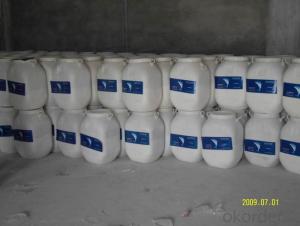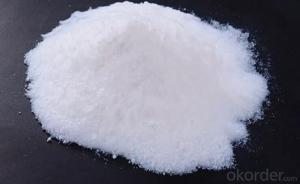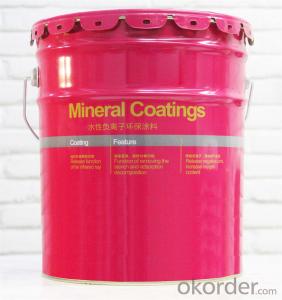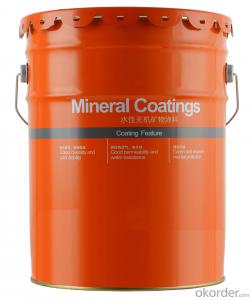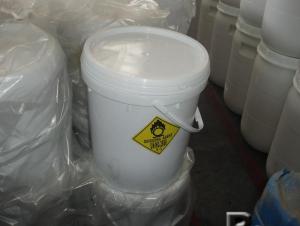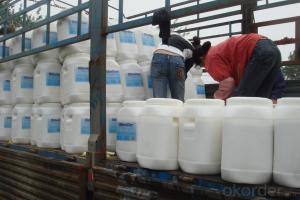Calcium Hypochlorite Water treatment Powder/Granlar/Tablets
- Loading Port:
- Tianjin
- Payment Terms:
- TT OR LC
- Min Order Qty:
- -
- Supply Capability:
- 10000MT m.t./month
OKorder Service Pledge
OKorder Financial Service
You Might Also Like
Calcium Hypochlorite
Introduction:
CNBM GROUP is the biggest water Treatment Factory in China. Our Product include: Calcium Hypochlorite, TCCA, SDIC, PAC, Sodium Sulphite, Sodium Thiosulfate etc.
CNBM One year can produce 18,000MT Calcium Hypochlorite with two model, one is 65% and one is 70%. More important we have 3 advantages, Firstly: High effective chlorine content Secondly: Good stability. Can be stored a long time at normal temperature with little chlorine loss; Third:Good solubility, less water-insoluble matters.
Technical Specifications:
Calcium Hypochlorite 65%
Index Name | Top Grade | First Grade |
Chlorine Content ≥ | 65% | 60% |
Moisture ≤ | 3% | 3% |
Yearly Loss of Active Chlorine | 8% | 8% |
Calcium Chloride | 9% | 10% |
Color | White or Light-grey | ----- |
Shape | Power & Granular |
|
Calcium Hypochlorite 70%
Index Name | Top Grade | First Grade | Quality Product |
Chlorine Content ≥ | 70% | 67% | 65% |
Granularity(14-50 mesh)% ≥ | 90 | 87 | 87 |
Moisture % | 5.5~10 |
|
|
Tablets Forms
Weight | 200 gram | 150gram | 100gram | 50gram | 30gram | 20gram | 15gram | 10gram |
Diameter(mm) | 76 | 70 | 50 | 42 | 30 | 30 | 30 | 30 |
Height(mm) | 25 | 21 | 26 | 27 | 22 | 16 | 12 | 8 |
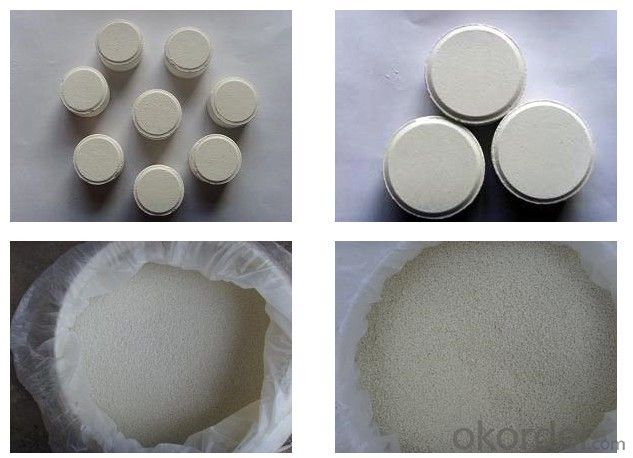
Applications:
1. For bleaching purpose of wood pulp, silk, cloth and fibre.
2. Disinfection and water-treatment.
3. Disinfectant for chemical poisonous and radioactive substance.
Formula Experiment Design: (Base on 1MT Water)
Constitue Dosage
Calcium Hypochlorite 65% 100kg
Disinfection Liquid 1% Calcium Hypochlorite 65% 1.7g
Shipping Containers:
45—50kg Plastic or Steel Drums with Inner Plastic Bag.
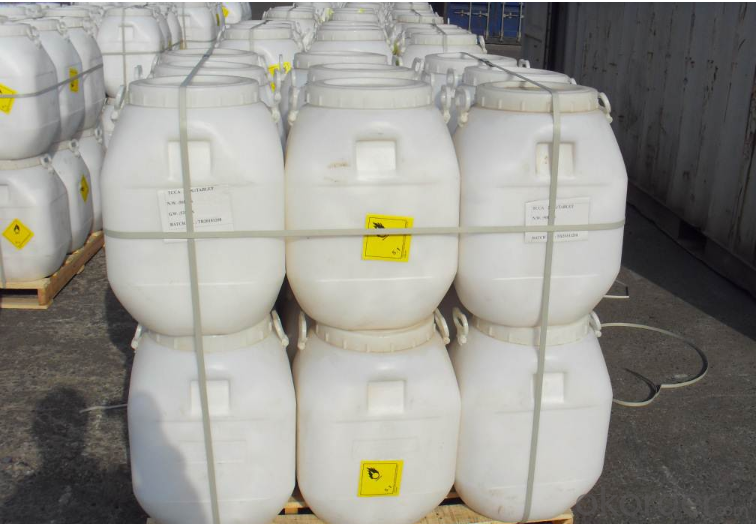

Cautions
1. Should be stored in cool and dry warehouse away from heating sources and avoid direct sunlight.
2. In transportation, contact with such should be avoided as sunlight, heating,moisture, organics, oil and acids.
Other Information please check the MSDS.
- Q:What is catalyst in Science?
- A catalyst is a substance that increases the rate of a reaction by decreasing the activation energy (energy required to start the reaction). It does so by creating a new reaction mechanism (the way the reaction happens on a molecular level) that happens more easily and with less energy. For example, a catalyst could attract both reactants, thus bringing them directly together and facilitating the reaction.
- Q:Does a catalyst work for both reactants and products?From my understanding, organic catalyst or enzyme does not necessarily work for the product of the reaction because of the shape of the activation site. However I cannot speak for inorganic ones.
- A catalyst works for either the reactants or the product in a given reaction. If it works for the reactants then the activation site on the enzyme, for example, will only fit on the reactants. If a catalyst is added to a reaction in which it catalyzes the back-reaction, or it aids the products, then the reaction will be reversed. i don't think a catalyst could work for both the reactants and products in one reaction because it wouldn't really be a catalyst anymore; it wouldn't make the rxn progress any faster since it would be canceling out itself by aiding both the reactants and the products. I think this is what you are asking, if not please post more details. I hope I didn't confuse you even more!
- Q:Can manganese dioxide be used as a catalyst for various chemical reactions?
- Manganese dioxide can be a catalyst for hydrogen peroxide decomposition, a catalyst for the preparation of chlorine gas from potassium chlorate, and the like can be reactants
- Q:Which branch of chemistry or what specialty can study the catalyst
- Analytical Chemistry: Application of Catalysts in Analytical Chemistry, Component Analysis of Certain Natural and Synthetic Catalysts
- Q:What is the standard for the storage of flammable and explosive chemicals now?
- First, the basic requirements of classification of storage Dangerous goods, variety, complex performance, storage, in accordance with the zoning, classification, sub-section of the principle of special storage, set the number, set the number of fixed warehouses, fixed staff (four) custody. Small warehouses should be classified, divided, sub-stack storage, the performance of each other, fire fighting different items, dangerous dangerous goods and other general dangerous goods, should be stored separately.
- Q:Could you please explain it, i know they increase reaction rates but how?
- A catalyst provides an alternative route for the reaction, (maybe more steps than previously), but each step having a lower activation energy than the original uncatalysed reaction. This means that although there will be the same number of collisions per second (if the reaction is performed at the same temperature as before), a greater fraction of those collisions will result in a reaction - so there will be more reactions per second. In the case of a heterogeneous catalyst - e.g. a solid surface the change is that the first step is a bond to the surface which waekens some of the bonds in the reactants - again making a greater fraction of reactions result in reaction.
- Q:Can a catalyst react with a reactant?
- Exactly no. A catalyst just provides a shortcut to a reaction and thats is by combining with the reactant and at end of reaction it splits from the reactant it combined with.if a catalyst reacts then it is not a catalyst
- Q:What is the chemical nature of the enzyme?
- Enzyme protein and cofactor are present in the absence of catalytic activity, only these two parts together to form a complex to show the catalytic activity of this complex called the whole enzyme. Some enzymes cofactor is the metal ion, some enzyme cofactor is Organic small molecules in these organic small molecules, where the enzyme and protein binding is called the auxiliary base; and with the enzyme protein binding was more relaxed, dialysis can be used to separate the enzyme protein is called coenzyme. There is no strict boundary between the base and the coenzyme, the role of the metal ion in the enzyme molecule, or as a component of the active site of the enzyme, or the conformation necessary to form the center of the enzyme, or between the enzyme and the substrate The same coenzyme is often able to bind to a variety of different enzyme proteins, the composition of a variety of catalytic functions of different enzymes, such as coenzyme Ⅰ (NAD +) can be a variety of enzymes, As a coenzyme for many dehydrogenases, but each enzyme protein can only bind to a specific coenzyme into a whole enzyme.It can be seen that the specificity of the enzyme is the enzyme protein part of the coenzyme in the enzymatic reaction is usually responsible for electrons, atoms Or some chemical groups to determine the nature of the reaction.In recent years, it has been found that, in addition to proteins, some RNA and DNA molecules also have a catalytic effect on the chemical nature of the enzyme is the concept of protein produced a strong impact . However, the now known enzymes are essentially protein-based, or protein-dominated core components, and the concept that the enzyme is a protein-based biocatalyst does not exclude the presence of other types of catalysts, and more precisely, Can be given to the enzyme under the definition of: the enzyme is a kind of biological activity and special space conformation of biological macromolecules, including protein and nucleic acid.
- Q:To write a 1500 words of small papers, so please help you busy
- Change the course of the reaction
- Q:Also, how is the catalyst affected by heat? Please answer all of the questions not just one of the three. THANK YOU!
- The catalyst is affected by vinegar because vinegar is acidic meaning there are more H+ ions. This alters the charges on the R groups of the amino acid residues of the enzyme molecule. The bonds that help maintain the conformation of the enzyme molecule which is ionic will therefore, be disrupted and the binding of substrate will be affected. However, if pH is restored to optimum pH, the maximum activity of the enzyme will be restored but this is only if the pH was only altered by a small extent. If pH is altered by a large extent, the conformation of the enzyme molecule will be severely affected causing it to denature. The catalyst is affected by heat because excessive heat disrupts the intermolecular bonds which stabilise the secondary and tertiary structure of an enzyme molecule(the enzyme molecule has a tertiary structure). The enzyme molecule unfolds and the precise shape of the active site is lost. This loss of structure and function is irreversible.
1. Manufacturer Overview |
|
|---|---|
| Location | |
| Year Established | |
| Annual Output Value | |
| Main Markets | |
| Company Certifications | |
2. Manufacturer Certificates |
|
|---|---|
| a) Certification Name | |
| Range | |
| Reference | |
| Validity Period | |
3. Manufacturer Capability |
|
|---|---|
| a)Trade Capacity | |
| Nearest Port | |
| Export Percentage | |
| No.of Employees in Trade Department | |
| Language Spoken: | |
| b)Factory Information | |
| Factory Size: | |
| No. of Production Lines | |
| Contract Manufacturing | |
| Product Price Range | |
Send your message to us
Calcium Hypochlorite Water treatment Powder/Granlar/Tablets
- Loading Port:
- Tianjin
- Payment Terms:
- TT OR LC
- Min Order Qty:
- -
- Supply Capability:
- 10000MT m.t./month
OKorder Service Pledge
OKorder Financial Service
Similar products
New products
Hot products
Hot Searches
Related keywords



